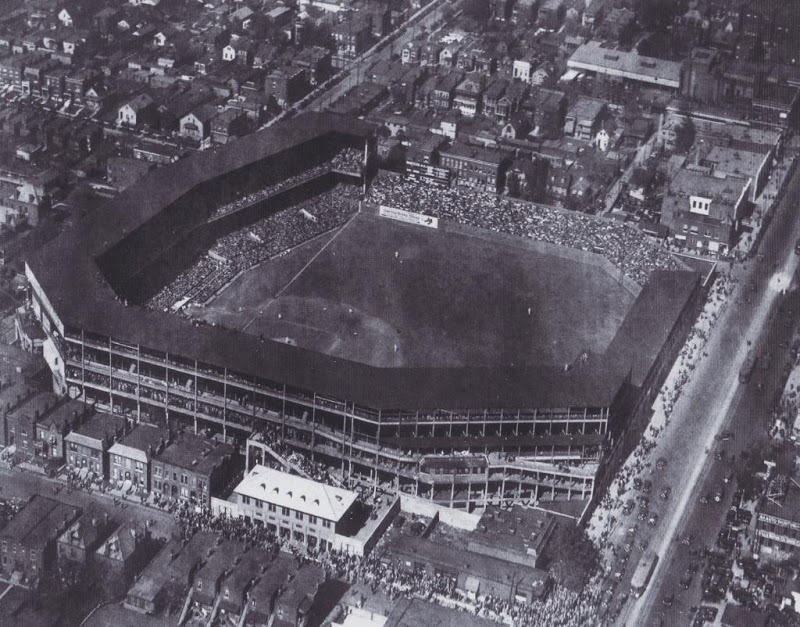 The following piece was written for the excellent Greater Greater Washington site. Following a contributor debate regarding the merits of a new urban NFL stadium in D.C., additional cities are thrown into the mix. The first post looks at Indianapolis and St. Louis, following on the GGW site will be Cincinnati, Chicago and Seattle.
The following piece was written for the excellent Greater Greater Washington site. Following a contributor debate regarding the merits of a new urban NFL stadium in D.C., additional cities are thrown into the mix. The first post looks at Indianapolis and St. Louis, following on the GGW site will be Cincinnati, Chicago and Seattle.
Each of the three St. Louis National Football League stadiums has been located in an urban setting. Sportsman’s Park was truly a neighborhood stadium, sharing an incredible likeness to Chicago’s Wrigley Field. A football field was shoe horned into Sportsman’s for six years.
When Busch Stadium I opened in 1966 it was one of a wave of dual use stadiums of similar design, started by DC’s own RFK stadium and followed by Philadelphia, Cincinnati, Pittsburgh and San Francisco. The stadium was home to Major League Baseball’s Cardinals and the Cardinals NFL team. Built during a period unprecedented faith in urban renewal in St. Louis, the stadium was one component of a larger effort that included the final clearing of a dozen city blocks for the Gateway Mall, the building of the Gateway Arch and construction of urban Interstates through the city.

{the original urban NFL stadium in St. Louis, Sportsmans Park}
The NFL left St. Louis in 1987 and local civic leaders went to work immediately to lure a team back to the city. Central to their strategy was the building of a domed stadium.
Completed in 1995, the Trans World Dome, now Edward Jones Dome, was built as a multi-purpose facility, following the then trend of combing convention centers with domed stadiums. It was one of the very last traditional dome stadiums built. The Dome’s utility as an expanded convention center has not lived up to initial promises for revenue generated and events held. The stadium even fails to offer a view of the Mississippi River, or the iconic Arch.
While an urban football stadium on the right site may add to and take advantage of a dramatic skyline, the stadium and convention center combination in St. Louis fails to do this. The stadium has arguably been an impediment to development. The 12 city block superblock is a defining barrier separating the near north side and the central business district to the south and last remnants of historic riverfront with the rest of the city.

{the Rams moved across downtown in 1995 – Busch I is soon to be demolished in this photo}
The nearest commercial corner at 7th and Washington is the site of a long vacant building encompassing an entire block and failed indoor urban mall. Both structures are currently undergoing development, two of the last to do so along the historic Washington Avenue corridor, and 15 years after the completion of the Dome. However with the surface parking lots, vacant land, and empty historic buildings surrounding the site, it’s a tough argument to say that things could have been worse.
At the time it was designed, the Dome was criticized by Eugene Mackey, a former president of the St. Louis Chapter of the American Institute of Architects, . St. Louis Post-Dispatch architecture critic E.F. Porter stated that such a structure at the edge of a struggling CBD would have a “pervasive and irreversible impact on the complexion of the city.” He described the project as a “great protective battlement…sealing off the CBD from the neighborhoods to the north.” Mackey summed it up: ‘It makes north St. Louis the loading dock for downtown.”
Development north of the Dome has been non-existent during the past 15 years. Plans have come and gone, gleaming renderings of Daniel Libeskind towers displayed. Development prospects haven’t been helped by the broken street grid I-70 has wreaked on the north side. Porter even predicted trouble when a new Mississippi River Bridge would eventually route I-70 over the river from Illinois and land north of the Dome at Cass Avenue. The bridge is under construction now and will land at Cass Avenue, but the ramps carry traffic west of the superblock.

{red approximates landing for new I-70 bridge exit north of downtown St. Louis}
The negative impact is more than a few vacant lots and blocks of housing, the Convention Center and Dome present a life-subduing façade, especially to the west and north. Would the Dome have been better situated on the east (or even west) riverbank with an open roof view of the St. Louis skyline? Perhaps a suburban stadium, nearer the region’s population center, approximately 12 miles west of downtown would have worked.
Although served by the light rail MetroLink line and Metro bus, such service can only accommodate a fraction of 66,965 fans who can fill the stadium. Transit works better for baseball, basketball and hockey crowds of 12-40,000.
Ultimately, urban stadiums can work and we’re left to wonder if the Convention Center and Dome have inflicted and maintained blight in the St. Louis CBD or whether it’s successfully served as a bulwark against decay in a city where these problems are clearly bigger than a football stadium.

{the Edward Jones Dome}

{a view of Sportsmans Park across North Grand Boulevard}

